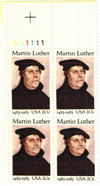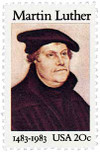
# 2065 - 1983 20c Martin Luther
U.S. #2065
1983 20¢ Martin Luther
- Issued to celebrate the 500th birth anniversary of Martin Luther, the namesake of Lutheranism.
Stamp Category: Commemorative
Value: 20¢, rate for first-class mail
First Day of Issue: November 11, 1983
First Day City: Washington, D.C.
Quantity Issued: 165,000,000
Printed by: American Bank Note Company
Printing Method: Photogravure
Format: Panes of 50 in Sheets of 200
Perforations: 11
Why the stamp was issued: To commemorate the 500th anniversary of Martin Luther’s birth. It was issued one day after his birthday.
The USPS generally tries to avoid stamps with religious subjects and aims to use stamp topics with close ties to US history. Luther was born in 1483 in Germany, centuries before the US was founded. In explaining the reason for the stamp, the USPS stated, “Luther made significant contributions to universal education, freedom of religion and expression, freedom of the press and the expansion of knowledge through the translation of Latin into the vernacular and the printing of books. This postage stamp was issued to commemorate his role in the growth of western civilization.”
About the stamp design: Graphic artist Bradbury Thompson based the stamp artwork on a portrait of Luther created in 1533 by Lucas Cranach. Cranach was Luther’s banker and a good friend.
History the stamp represents: In 1517, Martin Luther posted the 95 Theses on the door of the Catholic Church in Wittenberg, Germany. These Theses renounced many of the practices of the Catholic Church, and eventually led to Luther's excommunication.
Creation Of First Formal Lutheran Church Body in North America
On August 26, 1748, members of several Pennsylvania Lutheran communities met and agreed upon a common liturgy – the first in North America.
Swedes and Germans practicing Lutheranism had begun settling in Pennsylvania as early as 1638. They were drawn to the American colonies for the promise of religious freedom. Individual groups formed their own congregations. By the mid 1700s however, the need for well-trained preachers, elders, and deacons became apparent and a conference was planned.
Held in 1742, the conference hosted 24 German clergymen, including Henry Muhlenberg. However, tensions were high between the pious and orthodox sects both in America and abroad. The creators of this conference intentionally excluded orthodox representatives, who in turn disrupted the meeting. No progress was made at this time.
Five years later, Henry Muhlenberg requested that another conference be held in Philadelphia. Members from both sects were invited this time and on August 26, 1748, they met and agreed to work together as the “Ministerium of North America.” They established a common liturgy to be used in all American Lutheran churches. This meeting is often considered the most important event in North American Lutheranism.
The Ministerium operated informally until a constitution was established in 1781. Known as the German Evangelical Lutheran Ministerium of North America, its members spanned much of the colonies – from New York down to the Carolinas.
Over time, Lutheran congregations formed similar ministeriums, so the name was changed to The Ministerium of Pennsylvania and Adjacent States. Throughout the 1900s, the various congregations were unified several times. The most recent of these is the Evangelical Lutheran Church of America, which was established in 1988.
U.S. #2065
1983 20¢ Martin Luther
- Issued to celebrate the 500th birth anniversary of Martin Luther, the namesake of Lutheranism.
Stamp Category: Commemorative
Value: 20¢, rate for first-class mail
First Day of Issue: November 11, 1983
First Day City: Washington, D.C.
Quantity Issued: 165,000,000
Printed by: American Bank Note Company
Printing Method: Photogravure
Format: Panes of 50 in Sheets of 200
Perforations: 11
Why the stamp was issued: To commemorate the 500th anniversary of Martin Luther’s birth. It was issued one day after his birthday.
The USPS generally tries to avoid stamps with religious subjects and aims to use stamp topics with close ties to US history. Luther was born in 1483 in Germany, centuries before the US was founded. In explaining the reason for the stamp, the USPS stated, “Luther made significant contributions to universal education, freedom of religion and expression, freedom of the press and the expansion of knowledge through the translation of Latin into the vernacular and the printing of books. This postage stamp was issued to commemorate his role in the growth of western civilization.”
About the stamp design: Graphic artist Bradbury Thompson based the stamp artwork on a portrait of Luther created in 1533 by Lucas Cranach. Cranach was Luther’s banker and a good friend.
History the stamp represents: In 1517, Martin Luther posted the 95 Theses on the door of the Catholic Church in Wittenberg, Germany. These Theses renounced many of the practices of the Catholic Church, and eventually led to Luther's excommunication.
Creation Of First Formal Lutheran Church Body in North America
On August 26, 1748, members of several Pennsylvania Lutheran communities met and agreed upon a common liturgy – the first in North America.
Swedes and Germans practicing Lutheranism had begun settling in Pennsylvania as early as 1638. They were drawn to the American colonies for the promise of religious freedom. Individual groups formed their own congregations. By the mid 1700s however, the need for well-trained preachers, elders, and deacons became apparent and a conference was planned.
Held in 1742, the conference hosted 24 German clergymen, including Henry Muhlenberg. However, tensions were high between the pious and orthodox sects both in America and abroad. The creators of this conference intentionally excluded orthodox representatives, who in turn disrupted the meeting. No progress was made at this time.
Five years later, Henry Muhlenberg requested that another conference be held in Philadelphia. Members from both sects were invited this time and on August 26, 1748, they met and agreed to work together as the “Ministerium of North America.” They established a common liturgy to be used in all American Lutheran churches. This meeting is often considered the most important event in North American Lutheranism.
The Ministerium operated informally until a constitution was established in 1781. Known as the German Evangelical Lutheran Ministerium of North America, its members spanned much of the colonies – from New York down to the Carolinas.
Over time, Lutheran congregations formed similar ministeriums, so the name was changed to The Ministerium of Pennsylvania and Adjacent States. Throughout the 1900s, the various congregations were unified several times. The most recent of these is the Evangelical Lutheran Church of America, which was established in 1988.










